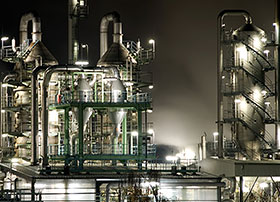

When an expensive control valve breaks down after three months only, a remedy is needed badly. But resin producer Ticona had to live with this situation for a considerable time due to its extraordinary production process. Thinking outside the box was the way out. Using an ‘exotic’ ball sector valve not only solved the problem, but also saved money.
The control valve was ready for scrapping after only three months, not some cheap plug valve made from low-quality steel, but rather a valve made from high-quality Hastelloy C. This situation could not be tolerated for long, but the harsh conditions in fibre enforced plastic production at Ticona meant that abrasion and corrosion occurred on the body, tapered seat or plug after only a short time, leading to total failure. Lift valves of the type used until the 1980s could not be considered because of the emissions regulations in ‘TA-Luft’. Thomas Labahn, the person responsible for plant planning and EMC at Ticona, took a look at the problem. This explains why he was very interested in a ball sector valve that he saw during a plant tour of the valve manufacturer Schubert & Salzer. “As soon as they explained the control valve to me, a light went on in my head,” is how Labahn describes his Eureka moment.
Ticona conducted a parallel test of a ball sector valve from Schubert & Salzer and one from another manufacturer. The latter valve lasted precisely three weeks before seizing up. The Schubert & Salzer valve on the other hand, lasted the distance. “The very first attempt was a major success. The valve lasted nearly 10 months, almost three times as long as before,” explains Labahn. The trick: the valve is made from standard material (stainless steel) and only has hard chrome-plated (stellited) ball sector surfaces. This is the reason why it is significantly less expensive than the previous valve made from Hastelloy. Furthermore, the damaged valve can be repaired and even costs a good deal less to buy than does the original plug valve. Considering the numerous control functions in which these valves are used at Ticona, under extremely challenging conditions, the saving potential is quite considerable.
A small actuator is sufficient
After 10 months in operation, only the holder of the seat ring had come loose, and the manufacturer is already working on a solution to this problem with an improved variant. “The media flows through the ball sector element in a totally different way than in the plug valve,” explains Labahn. “In future, completely stellated valves are expected to offer even greater improvements.”
Other important aspects in favour of using ball sector valves are their comparably light weight and relatively low actuator thrusts. The friction against the stuffing box seal in plug valves means they have a very high break-loose torque and this explains why they need powerful actuators. The torque with the ball sector valve, on the other hand, is relatively low and the actuators can be correspondingly smaller.
Furthermore, the valve does not get blocked because the entire pipe cross section is left unobstructed when the ball sector is fully open. The fibre enforced plastics manufacturer is also happy when it comes to the control response: “In our case, the control accuracy that has been achieved is comparable to that of the plug valve we used to use,” concludes Labahn.
Principle of the ball sector valve
The ball sector valve consists of a hemispherical shell – the ball sector – that is held securely in the valve body using two large bearing stems. Part of the hemispherical shell is used for isolating, while the other has a hole with a diameter corresponding to about 80% of the nominal size of the valve. The ball sector is turned through about 90o from fully open to closed. The shape of the opening cross section changes from completely round to elliptical in this case. This practically round shape for the flow opening reduces the risk of blockage when small control settings are made.
For more information contact Rowan Blomquist, Macsteel Fluid Control, +27 (0)11 383 4000, [email protected], www.macsteel.co.za

© Technews Publishing (Pty) Ltd | All Rights Reserved